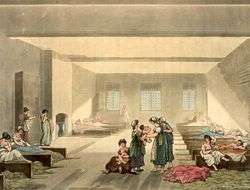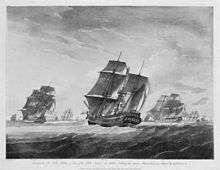Mary Wade
Mary Wade (17 December 1775 – 17 December 1859) was only 13 years old when transported to Australia as the youngest convict aboard Lady Juliana as part of the Second Fleet. Her family grew to include five generations and over 300 descendants in her own lifetime.
Mary Wade | |
|---|---|
| Born | 17 December 1775 St Margaret’s, Westminster, Middlesex, England |
| Died | 17 December 1859 (aged 82) |
| Spouse(s) | Jonathan Brooker |
| Children | Sarah William |
| Parent(s) | Lawrence Wade & Mary Smith of Westminster, Middlesex |
Early years in London

Early researchers in the 1980s believed that Mary was born on 5 October 1777 at Southwark, London to Mary English and George Wade and then christened on 21 December 1777 at Saint Olave, Southwark, Surrey, England. A new group of researchers with wider access to records that were not previously available now believe that Mary was born 17 December 1775, St Margaret’s, Westminster, Middlesex[1] and was baptised 7 January 1776, St Margaret’s, Westminster[2] to Lawrence Wade (died Aug 1794, Perkins Rents, Westminster[3]) and Mary Smith (died Nov 1836, 5 New Court, Westminster[4]). Evidence for her new date of birth and parents include:
1) Her mother stated during the trial that she was born in December.
2) Mary was living in St Margaret's parish in Westminster at the time of her arrest.
3) Her death certificate records that she was born in Westminster.[5]
If this new line of research is accurate, Mary had at least three siblings – Elizabeth Ann Wade (Born 5 February 1778 and Baptised 1 March 1778 at St Margaret's Westminster[6]); Henrietta (Born 17 November 1780 and Baptised 10 December 1780 at St Margaret's Westminster);[7] and Henry (Born 1 August 1786 and Baptised 20 August 1786),[8] died Apr 1793 and buried 24 April 1793 at St Margaret's[9]).
She spent her days sweeping the streets of London, as a means of begging. On 5 January 1789, Mary with another child, Jane Whiting, 14 years old, stole the clothes (one cotton frock, one linen tippet, one linen cap) from Mary Phillips, an 8-year-old, who at the time was collecting water in a bottle at a privy. They then sold the frock to a pawnbroker. Mary was reported by another child to an Officer of the Law who later found the tippet in Mary's room whereupon she was arrested and placed in Bridewell Prison. Her trial was held on 14 January 1789 at the Old Bailey, where she was found guilty and was sentenced to death by hanging.[10]
Penal transportation
On 11 March 1789, King George III was proclaimed cured of an unnamed madness; it is assumed that he suffered from porphyria, a degenerative mental disease. A month later, in the spirit of celebration, all the women on death row, including Mary Wade, had their sentences commuted to penal transportation to Australia. She spent 93 days in the Newgate Prison before being transported on Lady Juliana to Australia, which was the first convict ship to carry only women and children. After an 11-month voyage across the ocean, the ship arrived at Sydney on 3 June 1790 and Wade was sent on to Norfolk Island aboard HMS Surprize, arriving on 7 August 1790.
Life in Australia
Wade had 2 children on Norfolk Island; Sarah in 1793, Edward (born c1795 died c1796) and William in 1795. When they arrived back in Sydney, Mary lived with Teague Harrigan, with whom she had another two sons; Edward (born c1800 died 1803) and Edward (born 1803), in their tent on the banks of the Tank Stream in Sydney. Teague left to go on a whaling expedition in 1806 and by 1817 he was living in Port Dalrymple, Tasmania. He was granted land near the Tamar River in Launceston in 1825 and presumably never returned to the mainland.[11]

Marriage and family
Mary lived with Jonathan Brooker near the Hawkesbury River from 1809. It was here that Mary raised her family which numbered 21 children (current researchers question this assertion), seven of whom lived to have their own children. Jonathan was given his Certificate of Freedom in February 1811 and then given a grant of 60 acres (240,000 m2) at Tarrawanna, New South Wales by Governor Macquarie.[12] Mary finally received her Certificate of Freedom on the first of September 1812. In 1816 they settled on the property of Airds (made up of the modern suburbs of Airds, Bradbury, St Helens Park, Rosemeadow, among others) in Campbelltown, New South Wales with their family. Mary married Jonathan Brooker on 10 February 1817 at St Lukes, Liverpool, New South Wales and her husband owned 30 acres (1822) until bushfires destroyed their property (1823) whilst Jonathan's livelihood as a Chair-maker by trade ended as his tools were all destroyed. The family became destitute and pleaded to the Governor of the time, Governor Thomas Brisbane, for aid. They recovered with Mary and Jonathan going on to own 62 acres (250,000 m2) in Illawarra (1828). Here Mary lived until Jonathan's death on 14 March 1833, when he was buried in the graveyard of St. Peter's Church, Campbelltown, NSW. Mary died on 17 December 1859 (her birthday) at the age of 84, in Wollongong, New South Wales and her funeral service was the very first to be held in St Paul's Church of England, Fairy Meadow, New South Wales with her son donating the land on which the church was built.[13]
Legacy
At the time of her death, Mary had over 300 living descendants and is considered as one of the founding mothers of the early settlers to Australia. Today her descendants number in the tens of thousands, including Kevin Rudd, former Prime Minister of Australia.[14] Mary's story is told in the book Mary Wade to Us, published as a family tree, noted in the further reading below. This, and the stories of Rudd's other convict ancestors has now been collated into two leather-bound volumes by the Church of Jesus Christ of Latter-day Saints, which is kept in the National Library of Australia in Canberra.[15]
In 2017, the NSW Government named a remand centre for women in her honour.
References
- Westminster Baptisms- Transcripts, Westminster Archives. ST MARGARET, WESTMINSTER, 1519 – 1921. Transcriptions © brightsolid online. Find My Past Website.
- Westminster Baptisms- Transcripts, Westminster Archives. ST MARGARET, WESTMINSTER, 1519 – 1921. Transcriptions © brightsolid online. Find My Past Website.
- Burial books, 1783–1853 of St. John the Evangelist Church, Westminster. Transcripts @ Brightsolid. Find My Past Website.
- Burial books, 1783–1853 of St. John the Evangelist Church, Westminster. Transcripts @ Brightsolid. Find My Past.
- NSW BDM Registration Index Number 5613. NSW Department of Justice, Registry or Births, Deaths and Marriages.
- Westminster Baptisms- Transcripts, Westminster Archives. ST MARGARET, WESTMINSTER, 1519 – 1921. Transcriptions © brightsolid online. Find My Past Website.
- Westminster Baptisms- Transcripts, Westminster Archives, ST MARGARET, WESTMINSTER, 1519 – 1921. Transcriptions © brightsolid online, Find My Past Website.
- Westminster Baptisms- Transcripts, Westminster Archives, ST MARGARET, WESTMINSTER, 1519 – 1921. Transcriptions © brightsolid online publishing, Find My Past Website.
- Westminster Burials- Transcripts, Westminster Archives. Transcriptions © brightsolid online publishing, Find My Past Website.
- Old Bailey Proceedings Online (accessed 8 May 2008), Trial of Mary Wade, Jane Whiting. (t17890114-58, 14 January 1789).
- "One of Australia's founding mothers". Biography of Mary Wade. Perry Family History. Archived from the original on 29 September 2007. Retrieved 8 May 2008.
- "Tarrawanna, Parish of Woonona County of Camden". Place Names of Wollongong. Wollongong City Library. Archived from the original on 21 April 2008. Retrieved 8 May 2008.
- "Mary Wade (1778–1859), Pioneering Australian Matriarch". Female Firebrands and Reformers. Geocities eschiva. Archived from the original on 8 August 2009. Retrieved 8 May 2008.
- "They must answer with their lives". Kevin Rudd: The Biography. Penguin Group Australia. Archived from the original on 22 October 2009. Retrieved 8 May 2008.
- Barrowclough, Anne (1 August 2008). "Kevin Rudd descended from thieves and forgers". London: Times Online. Retrieved 1 August 2008.
Further reading
- Mary Wade to Us, 1778–1986: a family history, available at the National Library of Australia; ISBN 1-86252-078-X
- Mary Wade to Us, 1778–1986: a family history – online ebook
- Kevin Rudd – The Biography by Robert Macklin, Penguin Group; ISBN 978-0-670-07237-8
- The Floating Brothel: The Extraordinary True Story of an Eighteenth-Century Ship and its Cargo of Female Convicts by Siân Rees, Hyperion (publisher); ISBN 0-7868-6787-6, ISBN 978-0-7868-6787-5
External links
- The Mary Wade Family Association A community site for descendants of Mary Wade to preserve, share and extend the knowledge of their shared family history.
- The Floating Brothel (Synopsis), Film Australia, abc.net.au
- Making the 'Floating Brothel', Timewatch, bbc.co.uk
- Burial Records for Pioneer Park Cemetery, Wollongong, New South Wales; Note: Mary Wade is buried in married name of Mary Ann Brooker
- Christening Record for Mary Ann Wade
- Mary Wade: Sentenced to Hang – Aged 10, Your Archives.
- Secrets of the Dead, Interview with Siân Rees
- Convict Tales, Convicts to Australia
- So, Prime Minister, you're related to a thief and a forger, The Age, 1 August 2008